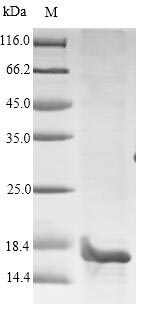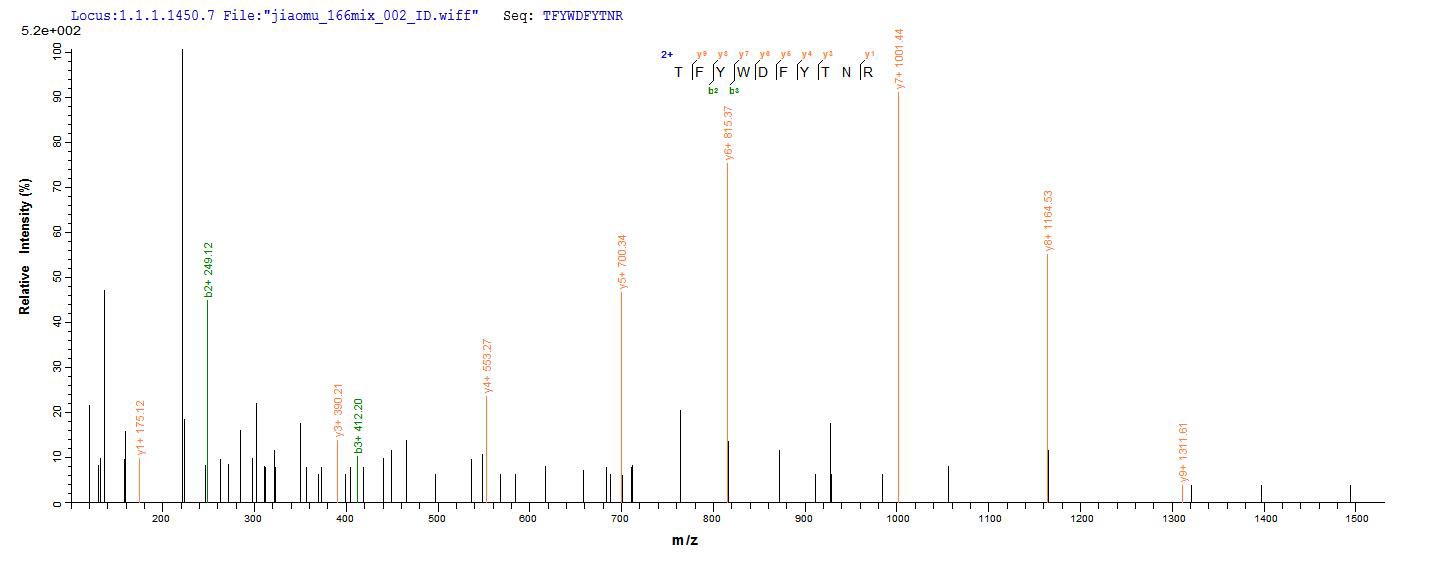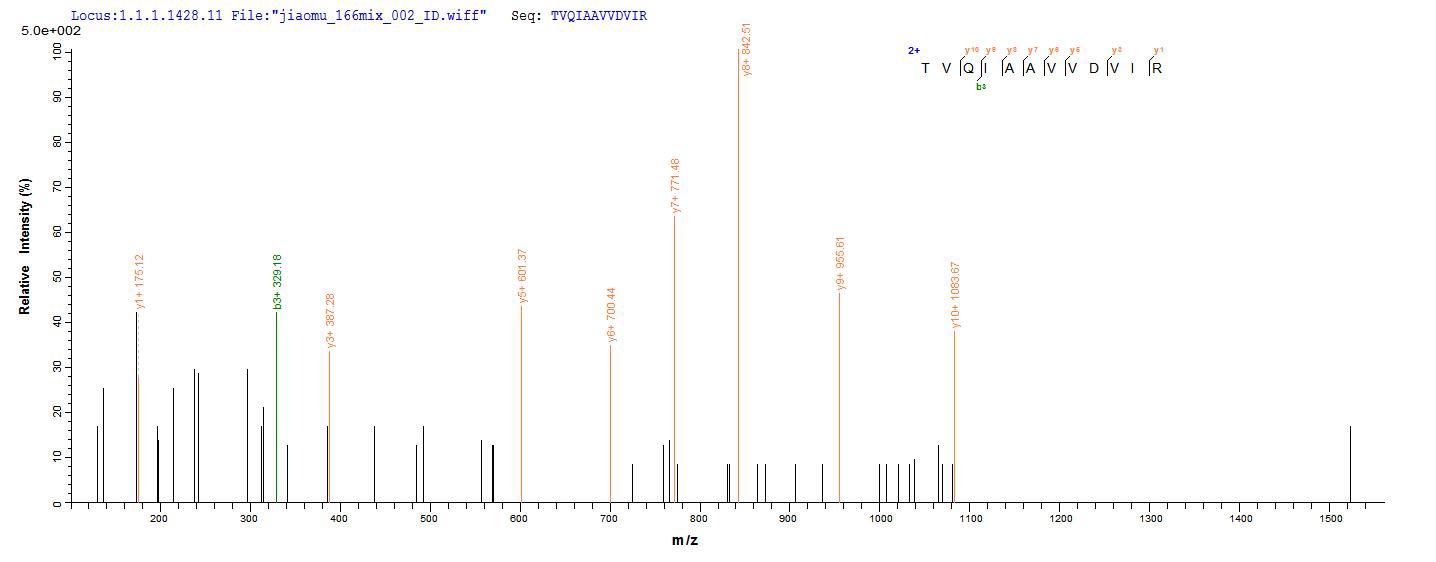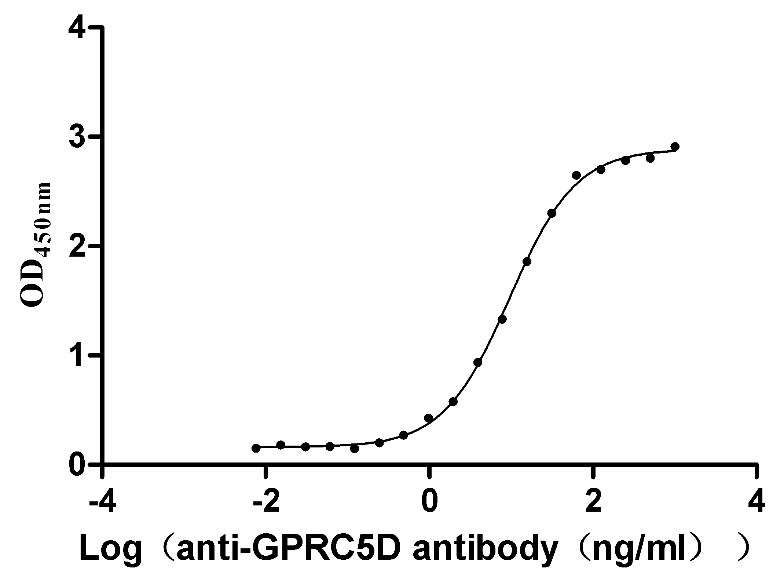Recombinant Human Prolactin-inducible protein (PIP)
-
中文名称:人PIP重组蛋白
-
货号:CSB-YP018020HU
-
规格:¥1500
-
图片:
-
(Tris-Glycine gel) Discontinuous SDS-PAGE (reduced) with 5% enrichment gel and 15% separation gel.
-
Based on the SEQUEST from database of Yeast host and target protein, the LC-MS/MS Analysis result of CSB-YP018020HU could indicate that this peptide derived from Yeast-expressed Homo sapiens (Human) PIP.
-
Based on the SEQUEST from database of Yeast host and target protein, the LC-MS/MS Analysis result of CSB-YP018020HU could indicate that this peptide derived from Yeast-expressed Homo sapiens (Human) PIP.
-
-
其他:
产品详情
-
纯度:Greater than 90% as determined by SDS-PAGE.
-
基因名:PIP
-
Uniprot No.:
-
别名:BRST-2; BRST2; GCDFP-15; GCDGP15; gp17; GPIP4; Gross cystic disease fluid protein 15; PIP; PIP_HUMAN; Prolactin induced protein; Prolactin inducible protein precursor; Prolactin-induced protein; Prolactin-inducible protein; SABP; Secretory actin binding protein; Secretory actin-binding protein
-
种属:Homo sapiens (Human)
-
蛋白长度:Full Length of Mature Protein
-
来源:Yeast
-
分子量:16.0kDa
-
表达区域:29-146aa
-
氨基酸序列QDNTRKIIIKNFDIPKSVRPNDEVTAVLAVQTELKECMVVKTYLISSIPLQGAFNYKYTACLCDDNPKTFYWDFYTNRTVQIAAVVDVIRELGICPDDAAVIPIKNNRFYTIEILKVE
Note: The complete sequence including tag sequence, target protein sequence and linker sequence could be provided upon request. -
蛋白标签:N-terminal 10xHis-tagged
-
产品提供形式:Liquid or Lyophilized powder
Note: We will preferentially ship the format that we have in stock, however, if you have any special requirement for the format, please remark your requirement when placing the order, we will prepare according to your demand. -
缓冲液:Tris-based buffer,50% glycerol
-
储存条件:Store at -20°C/-80°C upon receipt, aliquoting is necessary for mutiple use. Avoid repeated freeze-thaw cycles.
-
保质期:The shelf life is related to many factors, storage state, buffer ingredients, storage temperature and the stability of the protein itself.
Generally, the shelf life of liquid form is 6 months at -20°C/-80°C. The shelf life of lyophilized form is 12 months at -20°C/-80°C. -
货期:Basically, we can dispatch the products out in 1-3 working days after receiving your orders. Delivery time may differ from different purchasing way or location, please kindly consult your local distributors for specific delivery time.Note: All of our proteins are default shipped with normal blue ice packs, if you request to ship with dry ice, please communicate with us in advance and extra fees will be charged.
-
注意事项:Repeated freezing and thawing is not recommended. Store working aliquots at 4°C for up to one week.
-
Datasheet & COA:Please contact us to get it.
相关产品
靶点详情
-
基因功能参考文献:
- Unusual N-type glycosylation of salivary prolactin-inducible protein (PIP): multiple Lewis(Y) epitopes generate highly-fucosylated glycan structures. PMID: 29858715
- that GATA3 is a very sensitive marker for primary genital extramammary Paget diseases and is more sensitive than gross cystic disease fluid protein 15 PMID: 28693610
- monoclonal antibodies to GATA-3 are very sensitive reagents for the identification of breast CA, surpassing antibodies to GCDFP-15 and mammaglobin A, and offer a significant improvement in identifying TNBCs PMID: 26447897
- good coincidence was observed between primary and metastatic tumor GATA3 expression (kappa value = 0.826 >0.75) as compared with the coincidence of GCDFP15 (kappa value =0.492 <0.75) and mammaglobin (kappa value =0.593 <0.75) PMID: 28038704
- High expression of GCDFP-15 is associated with molecular apocrine breast cancer. PMID: 26711786
- While highly expressed under pathological conditions of the mammary gland, including breast cancers, PIP is expressed in very few other cancers. Although the function of PIP is not well elucidated, numerous studies suggest that its primary role may be related to host defense and immune modulation. Studies in Pip null mice suggest that PIP may play a similar immune-regulatory role in breast cancer. [Review] PMID: 27602994
- novel marker GATA3 stains a significantly higher proportion of both primary and metastatic breast carcinomas than GCDFP15 or mammaglobin with stronger and more diffuse staining, helpful in cases with small tissue samples PMID: 25906123
- In summary, this study suggests that PIP expression regulates the process of cell adhesion in breast cancer. PMID: 26585492
- GCDFP15 in stratum corneum is a potential marker for dysregulated sweating in atopic dermatitis. PMID: 25919462
- The commonly used breast carcinoma biomarkers vary in their prognostic implications. GCDFP-15 independently indicated a favourable prognosis. GATA-3 and MGB were not associated with outcome. PMID: 25425335
- Data indicate the potential role of Gross cystic disease fluid protein-15/prolactin-inducible protein (GCDFP-15/PIP) as a biomarker for keratoconus (KC)disease. PMID: 25405607
- Prolactin-induced protein mediates cell invasion and regulates integrin signaling in estrogen receptor-negative breast cancer. PMID: 22817771
- GCDFP-15 expression is higher in tumors with favorable prognostic features. GCDFP-15 expression is further a frequent feature of androgen receptor positive tumors and the molecular apocrine subtype. PMID: 25070172
- PIP is a breast cancer-related protein that is expressed in a majority of breast tumors and has a significant function in the biology of this disease. [review] PMID: 25472539
- we found that HER2 or GCDFP15 protein overexpression is a sensitive and specific tool to differentiate MA from BL in the context of ER negative tumors. PMID: 23663520
- The roles of PIP in the related T47D breast cancer cell line, were investigated. PMID: 23755096
- PIP is required for cell cycle progression in breast cancer and provides a rationale for exploring PIP inhibition as a therapeutic approach in breast cancer that can potentially target microtubule polymerization. PMID: 24862759
- Report GCDFP15 expression in metastatic basal-like triple negative breast carcinomas. PMID: 24272937
- AZGP1 and PIP were found in significantly lower levels in invasive breast tissue. PMID: 24114735
- GCDFP-15 was associated significantly with a breast cancer profile of good prognosis tumors. PMID: 23332923
- Gross cystic disease fluid protein-15 and mammaglobin A expression determined by immunohistochemistry is of limited utility in triple-negative breast cancer. PMID: 22963676
- Interaction analysis identifies semenogelin I fragments as new binding partners of PIP in human seminal plasma PMID: 23085372
- GCDFP-15 alone is not a useful marker to detect the metastasis of basaloid type breast cancers. PMID: 23011826
- expression was down-regulated in azoospermia, indicating that PIP may be a plausible marker of azoospermia PMID: 22724438
- The first report of native human serum albumin (HSA)-PIP complex formation in seminal plasma. PMID: 22209935
- abnormal development of the prepuce in hypospadias is associated with variation in PIP expression PMID: 21883842
- Data suggest that Runx2 controls a positive feedback loop between androgen signaling and PIP, and pharmacological inhibition of PIP may be useful to treat PIP positive tumors. PMID: 21809344
- Most basal-like breast carcinomas and unclassified triple-negative carcinomas are negative for mammaglobin and gross cystic disease fluid protein 15. PMID: 21411781
- expressed on a small subset of primary lung adenocarcinomas PMID: 19620839
- Intragenic amplification and formation of extrachromosomal small circular DNA molecules from the PIP gene on chromosome 7 in primary breast carcinomas PMID: 11992405
- different conformations and/or tissue-specific posttranslational modifications of the proteins, although their primary structure was identical by MS/MS analysis PMID: 12755619
- Forms a protein complex with PIG-F and is involved in the conversion of phosphatidylinositol glycans. PMID: 15632136
- The sensitivity of mammaglobin is equal or superior to that of GCDFP-15 for investigation of breast carcinoma. PMID: 18251583
- analysis of the novel complex formed between zinc alpha2-glycoprotein (ZAG) and prolactin-inducible protein (PIP) from human seminal plasma PMID: 18930737
- Both MGB1 and GCDFP-15 are specific markers for metastatic breast carcinomas in cell block fluid specimens (88 vs. 96%). PMID: 19217055
- importance of a regulatory subnetwork associated with PIP expression in which STAT5 appears as a potential transcriptional regulator PMID: 19262752
- PIP(alternate name GCDFP-15, gp17) is a secretory marker of apocrine differentiation in breast carcinoma. It is an aspartyl proteinase with specificity restricted for fibronectin. PMID: 10713110
显示更多
收起更多
-
亚细胞定位:Secreted.
-
蛋白家族:PIP family
-
组织特异性:Expressed in pathological conditions of the mammary gland and in several exocrine tissues, such as the lacrimal, salivary, and sweat glands.
-
数据库链接:
HGNC: 8993
OMIM: 176720
KEGG: hsa:5304
STRING: 9606.ENSP00000291009
UniGene: Hs.99949
Most popular with customers
-
Recombinant Human T-cell surface protein tactile (CD96), partial (Active)
Express system: Mammalian cell
Species: Homo sapiens (Human)
-
Recombinant Mouse Prolactin receptor (Prlr), partial (Active)
Express system: Mammalian cell
Species: Mus musculus (Mouse)
-
Recombinant Human G-protein coupled receptor family C group 5 member D (GPRC5D)-VLPs (Active)
Express system: Mammalian cell
Species: Homo sapiens (Human)
-
Recombinant Mouse Retinol-binding protein 4 (Rbp4) (Active)
Express system: Mammalian cell
Species: Mus musculus (Mouse)
-
Recombinant Human Cadherin-17 (CDH17), partial (Active)
Express system: Mammalian cell
Species: Homo sapiens (Human)
-
Recombinant Rat Gastric inhibitory polypeptide receptor (Gipr), partial (Active)
Express system: Mammalian cell
Species: Rattus norvegicus (Rat)
-
Recombinant Human CD81 antigen (CD81), partial (Active)
Express system: Mammalian cell
Species: Homo sapiens (Human)
-
Recombinant Mouse Cytotoxic and regulatory T-cell molecule (Crtam), partial (Active)
Express system: Mammalian cell
Species: Mus musculus (Mouse)





-AC1.jpg)

















